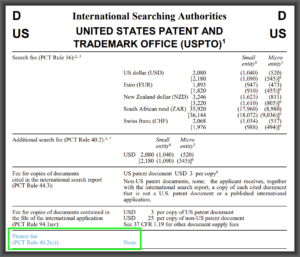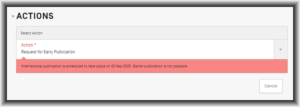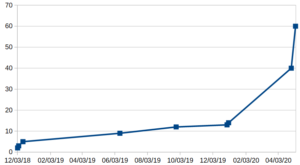
Here is an example of a patent office being remarkably responsive to a user concern.
Continue reading “An example of Patent Office responsiveness”

Bluesky: @oppedahl.com

Here is an example of a patent office being remarkably responsive to a user concern.
Continue reading “An example of Patent Office responsiveness”
 In the PCT listserv, a practitioner recently exasperatedly asked:
In the PCT listserv, a practitioner recently exasperatedly asked:
What is the protest fee in the International Searching Authority at the USPTO?
The movie Airplane makes clear how such a question should be answered.
Rumack (Leslie Nielson): You’d better tell the Captain we’ve got to land as soon as we can. This woman has to be gotten to a hospital.
Elaine Dickinson (Julie Hagerty): A hospital? What is it?
Rumack: It’s a big building with patients, but that’s not important right now.
So we realize the answer is:
It’s a fee that you pay if you have been invited to pay additional search fees and if you wish to protest the finding of a lack of unity of invention. But that’s not important right now.
Later in the same movie the following exchange occurs:
Elaine Dickinson: You got a letter from headquarters this morning.
Ted Striker: What is it?
Elaine Dickinson: It’s a big building where generals meet, but that’s not important.
Note the particular cleverness that Elaine delivers the straight line in the first exchange, and having learned how to be funny about this, in the second exchange she is the one to deliver the punch line.
Of course there is always the chance, however remote, that the practitioner was really asking something like:
What is the amount of the protest fee in ISA/US?
This turns out to be a very interesting question, and it prompted me to look up and compare the protest fees in each of the twenty-three ISAs. Here is the answer. Continue reading “What is the protest fee in ISA/US?”
![]() When I was first in patent practice, the only way to pursue patent protection in Italy from a PCT application was to enter the European regional phase. There simply was no national-only route to Italy from the PCT.
When I was first in patent practice, the only way to pursue patent protection in Italy from a PCT application was to enter the European regional phase. There simply was no national-only route to Italy from the PCT.
And so things have remained for years and years, until July 1, 2020. On July 1, 2020 Italy, the eighth-largest economy in the world when ranked by gross domestic product, opened a national-phase route from PCT.
You can read all about this in the Italian National Chapter Annex in the PCT Applicant’s Guide.
It is interesting to think about fact patterns that might prompt a filer to make use of this filing path. Clearly one fact pattern that might call for this filing path is if the applicant particularly needs protection in Italy, more than in any other country that belongs to the EPO. Instead of spending all of the money that has to be spent for entering the regional phase in EPO, the filer might only need to spend the money for a national-phase entry in Italy.
Another fact pattern conceivably calling for an Italian national-phase entry might be if an applicant is particularly interested in obtaining utility model protection in Italy. Italy has utility model protection as one of its available protection mechanisms, while EPO does not.
Here are some of the most important things to know about Italian national-phase entry from the PCT:
I have to imagine that this recent development must be very popular with patent firms in Italy, since it represents an opportunity to earn a professional fee carrying out a task which previously was not possible to carry out. Indeed I clicked around on the Internet and found many a patent firm in Italy that has posted an article on its web site letting readers know that the firm stands ready to attend to such an Italian national-phase filing.
Have you carried out such an Italian national-phase entry from a PCT? Do you plan to do so? If so, what circumstance is prompting such a plan? Please post a comment below.
In an earlier blog article I wrote about the “Captain May I?” problem. This is the problem that arises if a Hague Agreement filer (the filer of an international design application) designates the US, and if the filer claims priority from a non-US design application, and if the filer relies upon DAS as the way to provide the certified copy of the priority application to the USPTO. In that blog article I described that for two and a half years now, the USPTO has been aware of the fact that Hague filers often use Form DM/1 as a way to provide a priority claim and its DAS access code. USPTO interprets its own 37 CFR § 1.55 in such a way that the electronic copy of the priority application that USPTO retrieves from DAS, using that DAS access code, does not count as a “certified” copy unless the Hague filer also files an Application Data Sheet presenting the priority claim all over again.
It would have been helpful if USPTO had touched up 37 CFR § 1.55 a year ago, or two years ago, or two and a half years ago, to fix the perceived problem in the rule that leads to this otherwise completely unnecessary duplicate presentation of the priority claim. USPTO’s foot-dragging on this has led to an accumulation of two and a half years’ worth of issued US design patents that have a cloud over them if they claim foreign priority and made use of DAS.
Upon a bit of reflection I realize that this “Captain May I?” problem with USPTO’s interpretation of its own 37 CFR § 1.55 can also put a cloud over a US utility patent if it comes from a PCT application. Continue reading “The “Captain May I?” problem can arise in PCT cases too”
![]()
 I am delighted to report that two more Offices have announced their participation in the DAS system. These are the Italian Patent and Trademark Office and the Superintendence of Industry and Commerce of Colombia (the Colombian patent and trademark office). Here are details of the Depositing-Office participations:
I am delighted to report that two more Offices have announced their participation in the DAS system. These are the Italian Patent and Trademark Office and the Superintendence of Industry and Commerce of Colombia (the Colombian patent and trademark office). Here are details of the Depositing-Office participations:
| Colombia is a Depositing Office? | Italy is a Depositing Office? | |
| National industrial design applications | yes since August 28, 2020 | yes since October 1, 2020 |
| National patent applications | yes since August 28, 2020 | yes since October 1, 2020 |
| National trademark applications | yes since October 1, 2020 | |
| National utility model applications | yes since August 28, 2020 | yes since October 1, 2020 |
| PCT international applications filed With the office as a PCT receiving office |
yes since August 28, 2020 | yes since October 1, 2020 |
One striking aspect of this is the participation of RO/CO and RO/IT as Depositing Offices. This reminds us that among the IP5, the straggler Receiving Offices are RO/JP, RO/KR, and RO/US.
Note, too, the ever-increasing participation of Offices in DAS with respect to trademarks.
This also offers a reminder that these two Offices offer utility model protection.
Here are details of Colombia’s Accessing-Office participation:
| Colombia is an Accessing Office? | |
| Hague international applications | yes since August 28, 2020 |
| National industrial design applications | yes since August 28, 2020 |
| National patent applications | yes since August 28, 2020 |
| National trademark applications | yes since August 28, 2020 |
Who is the most trendy, modern and up-to-date Colombian intellectual property firm? Be the first to provide to me an application number, filing date, and DAS access code for a design application, a patent application, a utility model application, and an RO/CO application, and I will recognize your status as the most trendy, modern and up-to-date in Colombia. (I will blur part of the application number in the Certificates of Availability that I obtain and post.)
Who is the most trendy, modern and up-to-date Italian intellectual property firm? Be the first to provide to me an application number, filing date, and DAS access code for a design application, a patent application, a trademark application, a utility model application, and an RO/IT application, and I will recognize your status as the most trendy, modern and up-to-date in Italy. (I will blur part of the application number in the Certificates of Availability that I obtain and post.)

The normal timetable for publication of a PCT application is about 18 months after the priority date. But you can request that it be published early. What does this cost? How does one decide whether or not to make such a request? Continue reading “Requesting early PCT publication”

US national phase entries in Patentcenter are assigned from a block of application numbers starting at 15/733,001. Our firm was the third ever to file a 371 case in Patentcenter, receiving application number 15/733,003.
By the end of 2019, there had been fifteen 371 cases filed. My firm had filed seven of those cases. Yes my firm had done about half of all of the US national-phase work in Patentcenter from the beginnings of alpha test until the end of 2019.
By now, with Patentcenter opening up for general use, there has been an uptick in national-phase filings in Patentcenter. Twenty of them have been filed just in the past eight days.

One of the reasons why filers need to start learning to use ePCT (if they have not done so already) is that some day PCT-SAFE will be gone. Yesterday, PCT-SAFE took one more step towards oblivion. Continue reading “PCT-SAFE — one more step towards oblivion”
Hello faithful readers. On March 30 WIPO announced that it was ceasing the mailing of paper relating to PCT applications due to the work-from-home challenges from Covid-19. On that day I announced that I would be presenting a webinar on how to become paperless with PCT. The webinar took place. There was a lot of very helpful audience participation and I think the webinar went well as a consequence.
You can download the slides here and you can view a recording of the webinar here.
Please post comments below.
(Followup: You can download the presentation slides and you can view a recording of the webinar. For more information see this blog article.)
Many readers of this blog are already set up to be paperless in all of their PCT activities. This blog article is directed specifically to those who had not, until now, gotten set up to be paperless with PCT. Such filers are affected by this announcement today from WIPO:
Due to the effects of the COVID-19 pandemic on the operations of the International Bureau and of postal systems worldwide, the International Bureau, also in its function as receiving Office, has suspended the sending of PCT documents (e.g. PCT Forms, letters) on paper.
If you are a filer who has not, until now, gotten set up to be paperless with PCT, then I strongly urge you to attend two free webinars which will take place on Wednesday, April 1 and Thursday, April 2. In these webinars, you will:
In your existing and pending PCT applications, maybe you have not already provided an email address which WIPO and the International Searching Authority and the International Preliminary Examining Authority can use to send you correspondence electronically rather than on paper. In this webinar, learn how to provide such an email address to WIPO for this purpose for your existing and pending PCT applications.
The ePCT system has a function that is similar to Private PAIR in that it permits you to see the content and status of your pending PCT applications even if they have not yet been published, just as Private PAIR lets you see the content and status of your pending US application. In this webinar, learn how to gain access to your pending PCT applications in ePCT. In other words, learn how to use the feature of ePCT that is similar to Private PAIR with your existing and pending PCT applications.
When you file a new PCT application tomorrow or next week, you simply must file it in such a way that you will be able to see it in the part of ePCT that is similar to Private PAIR. In this webinar, learn what you need to do when you are filing a new PCT application so that you will be able to see it in the part of ePCT that is similar to Private PAIR.
Going forward, you absolutely need to not send anything on paper to WIPO. In this webinar, learn how to use the DAS system to send electronic certified copies of priority applications to WIPO (instead of physical certified copies). Learn how to use ePCT to send other communications to WIPO. Learn the difference between “ePCT actions” and “ePCT uploads” and learn which is better for you to use.
Please understand that the Part-1 webinar is an absolute prerequisite for the Part-2 webinar. You absolutely must attend Part 1 if you are going to attend Part 2.
Your presenter is Carl Oppedahl. Carl has lectured frequently about Best Practices for e-filing of PCT applications.